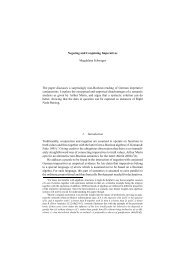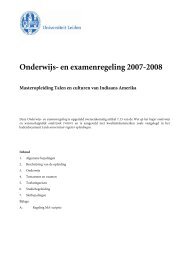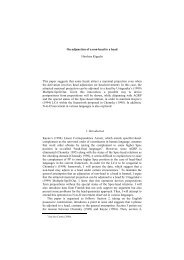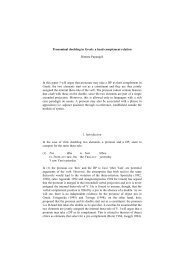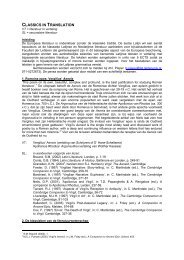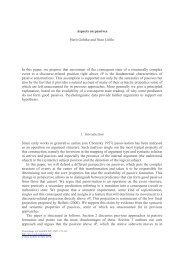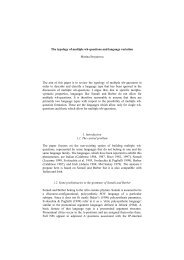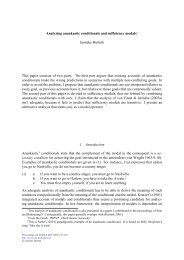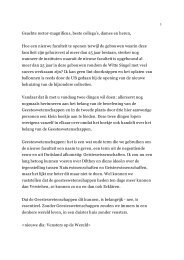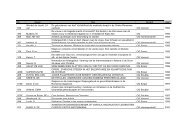Transparent free relatives Carla Schelfhout, Peter-Arno Coppen ...
Transparent free relatives Carla Schelfhout, Peter-Arno Coppen ...
Transparent free relatives Carla Schelfhout, Peter-Arno Coppen ...
You also want an ePaper? Increase the reach of your titles
YUMPU automatically turns print PDFs into web optimized ePapers that Google loves.
<strong>Transparent</strong> <strong>free</strong> <strong>relatives</strong><br />
<strong>Carla</strong> <strong>Schelfhout</strong>, <strong>Peter</strong>-<strong>Arno</strong> <strong>Coppen</strong> & Nelleke Oostdijk<br />
This paper describes the transparent <strong>free</strong> relative construction as a variant of<br />
the <strong>free</strong> relative construction. Four analyses are described, viz. the backward<br />
deletion analysis, the shared structure analysis, the standard analysis and the<br />
parenthetical analysis. It is demonstrated that of these analyses the<br />
parenthetical analysis is the superior one.<br />
1. Introduction<br />
Relative clauses can be divided into two classes: dependent relative clauses and<br />
independent relative clauses. The latter are also known as nominal or <strong>free</strong><br />
relative clauses. Dependent relative clauses depend on a certain referent in the<br />
clause, which is referred to by the relative pronoun, as exemplified in (1a).<br />
Independent relative clauses do not have a referent in the clause and behave as<br />
nominal expressions, as exemplified in (1b).<br />
(1) a. The things that you see belong to me.<br />
b. What you see belongs to me.<br />
As we see, the finite verb in (1a) shows number agreement with the referent,<br />
whereas the finite verb in (1b) has singular number. Apparently, <strong>free</strong> <strong>relatives</strong><br />
are syntactically singular, independent of what they refer to. This, however, is<br />
not always true; cf. example (2):<br />
(2) What seem to be pebbles are strewn across the lawn.<br />
In this sentence, we have a <strong>free</strong> relative clause which shows plural number<br />
agreement. This construction was called transparent <strong>free</strong> relative by Wilder<br />
(1999) and derives its name from the fact that the relative clause seems<br />
transparent with respect to the plurality of pebbles.<br />
We will discuss transparent <strong>free</strong> <strong>relatives</strong> in both English and Dutch, under<br />
the assumption that these constructions are comparable. We will first take a
82<br />
<strong>Schelfhout</strong>, <strong>Coppen</strong> & Oostdijk<br />
closer look at the characteristics of transparent <strong>free</strong> <strong>relatives</strong>, then discuss<br />
previous analyses and finally present an alternative analysis.<br />
2. <strong>Transparent</strong> <strong>free</strong> <strong>relatives</strong><br />
<strong>Transparent</strong> <strong>free</strong> <strong>relatives</strong> differ from standard <strong>free</strong> <strong>relatives</strong> in the following<br />
respects:<br />
A. Number. As discussed in section 1, <strong>free</strong> <strong>relatives</strong> always have singular<br />
number, 1 whereas the number of transparent <strong>free</strong> <strong>relatives</strong> may vary:<br />
(3) a. What you ordered was/*were delivered a minute ago.<br />
b. What John calls pebbles are lying on the lawn.<br />
c. What John calls a banjo is lying on his desk.<br />
B. Definiteness. Standard <strong>free</strong> <strong>relatives</strong> are definite, whereas the definiteness<br />
of transparent <strong>free</strong> <strong>relatives</strong> may vary. Definiteness can be checked by placing<br />
the <strong>free</strong> relative at an indefinites-only position, e.g. the existential construction<br />
there is something somewhere, where something can only be indefinite. 2<br />
(4) a. * There is what you ordered on your desk.<br />
b. There is what John might call a banjo on his desk.<br />
c. * There is what John might call his banjo on his desk.<br />
C. Reference. Standard <strong>free</strong> <strong>relatives</strong> cannot refer to human beings, whereas<br />
transparent <strong>free</strong> <strong>relatives</strong> can.<br />
(5) a. # What I adore kisses me.<br />
b. What I could best describe as my idol kisses me.<br />
c. # What I could best describe as my school kisses me.<br />
D. Island effects. Standard <strong>free</strong> <strong>relatives</strong> show island effects, whereas<br />
transparent <strong>free</strong> <strong>relatives</strong> do not.<br />
(6) a. John will deliver whatever you order him to.<br />
b. * Who will John deliver whatever you order e to?<br />
c. John is what you might call angry about something.<br />
d. What is John what you might call angry about e?<br />
1 There are two apparent exceptions on this rule: copulative or predicative constructions, in<br />
which the number of the predicate may decide on the number of the verb (what you see is a<br />
beautiful girl vs. what you see are beautiful girls), and cleft constructions (Whatever (it is that)<br />
John calls pebbles are…)<br />
2 Not to be confused with place adverbs, as in On your desk, there is what you ordered.
<strong>Transparent</strong> <strong>free</strong> <strong>relatives</strong> 83<br />
It can be observed that the number, definiteness and reference of the total<br />
transparent <strong>free</strong> relative is determined by the number, definiteness and<br />
reference of the right-peripheral XP in the transparent <strong>free</strong> relative, which we<br />
will pre-theoretically refer to as content kernel. For instance, pebbles and a<br />
banjo in (3b) are content kernels.<br />
So far we have seen characteristics of transparent <strong>free</strong> <strong>relatives</strong> that differ<br />
from the characteristics of standard <strong>free</strong> <strong>relatives</strong>. When we take a closer look<br />
at constructions that showed these characteristics, we notice that they all have<br />
the following characteristics as well:<br />
• whatever the nature of the content kernel, the relative can only be<br />
what; cf. (7a) to (7b):<br />
(7) a. What John might call sweet children are ruining my house.<br />
b. * Who John might call sweet children are ruining my house.<br />
• The main verb requires a predicate; this can be seen as only<br />
constructions in which the verb requires a predicate can occur at<br />
indefinites-only positions:<br />
(8) a. There is what John might call a banjo on your desk.<br />
b. * There is what John painted blue on your desk.<br />
• The content kernel can always replace the total transparent <strong>free</strong><br />
relative.<br />
(9) a. There is what John might call a banjo on your desk.<br />
b. There is a banjo on your desk.<br />
(10)a. These are errors which John is what you might call angry about.<br />
b. These are errors which John is angry about.<br />
It is clear that the content kernel plays a crucial role in a transparent <strong>free</strong><br />
relative. The content kernel decides about number, definiteness and reference<br />
of the total construction; in fact it can always replace the total construction of.<br />
How is this possible? The next section discusses three analyses that have been<br />
offered in the literature.<br />
3. Previous analyses of transparent <strong>free</strong> <strong>relatives</strong><br />
3.1 Wilder’s analysis: parenthetical placement with backward deletion<br />
Wilder (1999) proposes a parenthetical analysis for transparent <strong>free</strong> <strong>relatives</strong> in<br />
combination with deletion of one of two instances of the content kernel.<br />
Wilder's explanation consists of two steps: first, a complete relative clause<br />
(what he took to be a banjo) is parenthetically inserted into a matrix clause
84<br />
<strong>Schelfhout</strong>, <strong>Coppen</strong> & Oostdijk<br />
(John bought a banjo), left adjacent to the element that it premodifies (a<br />
banjo). Next, the predicate in the relative clause (a banjo) is deleted under<br />
morpho-phonological identity with the right adjacent element(s) in the matrix<br />
clause. For this deletion Wilder uses a rule named Backward Deletion, which<br />
he developed in Wilder (1997) for Right Node Raising. This rule deletes one<br />
constituent under identity with a second one. Wilder's analysis looks as<br />
follows:<br />
(11) John bought [ par what he took to be a banjo] a banjo.<br />
Wilder argues that the content kernel must be in the matrix clause, as this<br />
appears to be the most straightforward way to explain why this content kernel<br />
decides about number agreement and definiteness of the total construction. If<br />
the content kernel is in the main clause and the relative clause functions as a<br />
kind of premodifier to it, of course the number, definiteness and reference of<br />
the content kernel are decisive. However, this implies that the obligatory<br />
predicate role of the verb in the relative clause is either lacking or<br />
phonologically empty. In Wilder's view, it is phonologically deleted.<br />
3.2 Van Riemsdijk’s analysis: shared structures<br />
In several papers (Van Riemsdijk 1998, 2000, 2001), Van Riemsdijk develops<br />
a notion of shared structures, in which constituents are shared by two different<br />
clauses. His examples include right node raising constructions, wh-prefixes and<br />
transparent <strong>free</strong> <strong>relatives</strong>. For these, Van Riemsdijk defends an analysis in<br />
which the content kernel is shared by the matrix clause and the relative clause,<br />
as exemplified below:<br />
(12)<br />
John bought<br />
what he took to be } a banjo<br />
In the linearization of this structure the banjo has to be at one specific<br />
position only, but this one element is at two positions in the syntactic tree. This<br />
explains the behavior of transparent <strong>free</strong> <strong>relatives</strong> with respect to number,<br />
definiteness and island effects in the same way as Wilder defends it: by stating<br />
that the content kernel is in the main clause. The difference is in the<br />
explanation of the apparently empty predicate in the relative clause: whereas<br />
Wilder gives an analysis in which one instance of the content kernel, in the<br />
relative clause, gets deleted, Van Riemsdijk states that the same element is<br />
present in both clauses. 3 Hence, in the present example a banjo is both the<br />
3 One of Van Riemsdijk's arguments for this analysis is that it is also applicable to transparent<br />
<strong>free</strong> <strong>relatives</strong> that have the content kernel preceding the verb of the relative clause instead of being<br />
right peripheral to it. This variant does not exist in English, but it is present in Dutch and German,<br />
as exemplified below:
<strong>Transparent</strong> <strong>free</strong> <strong>relatives</strong> 85<br />
direct object of bought and the predicate of took to be, which implies that all<br />
argument roles are filled and that both clauses are syntactically correct.<br />
3.3 Grosu's analysis: standard analysis<br />
Grosu (2003) argues for the same analysis for standard and transparent <strong>free</strong><br />
<strong>relatives</strong>. In his view, the word what is the head of the construction and the<br />
content kernel is in the relative clause, as illustrated below:<br />
(13) features<br />
John bought [ rel what he took to be a banjo].<br />
The fact that the total transparent <strong>free</strong> relative has the number<br />
characteristics and the syntactic category of the content kernel is the result of<br />
two characteristics of the word what: it is underspecified with respect to<br />
number and syntactic category and it is the head of a small clause (one of the<br />
definitional characteristics of transparent <strong>free</strong> <strong>relatives</strong> is that the main verb<br />
always takes a predicate). The word what originates in the small clause and<br />
receives its number and other features from the predicate under equation with<br />
it; it is then successively A-moved to the specifier position of the matrix clause.<br />
This explains the definitional characteristic of transparent <strong>free</strong> <strong>relatives</strong> that the<br />
relative always has to be what: other <strong>relatives</strong> are not underspecified for<br />
number or syntactic category and hence they cannot take the value of<br />
predicates in a small clause.<br />
4. Discussion<br />
4.1 Previous analyses<br />
We will compare the previous analyses on the basis of the predictions they<br />
make with respect to the surface form and behavior of transparent <strong>free</strong><br />
<strong>relatives</strong>. First, we consider the predictions with respect to island effects. It is<br />
widely accepted that a subordinate clause forms an island for extraction. This<br />
holds a fortiori for wh-clauses; however, extraction out of a content kernel<br />
seems possible, as evidenced by example (6), repeated here for convenience:<br />
Hij is wat je mooi noemt.<br />
He is what one beautiful calls<br />
'He is what one calls beautiful.'<br />
In our view, these constructions are not comparable to the transparent <strong>free</strong> <strong>relatives</strong> we have<br />
described in section 1. These constructions can only be singular, do show island effects and behave<br />
exclusively nominally whereas we will see in section 4.2 that transparent <strong>free</strong> <strong>relatives</strong> show a<br />
wider distribution.
86<br />
<strong>Schelfhout</strong>, <strong>Coppen</strong> & Oostdijk<br />
(6) a. John will deliver whatever you order him to.<br />
b. * Who will John deliver whatever you order e to?<br />
c. John is what you might call angry about something.<br />
d. What is John what you might call angry about e?<br />
The fact that extraction out of a content kernel is possible suggests that this<br />
kernel is not in the subordinate clause. This makes Grosu's standard analysis, in<br />
which the content kernel is in the subordinate clause, less attractive.<br />
Next, we inspect the predictions with respect to the content kernel that the<br />
shared structure analysis and the backward deletion analysis make. A shared<br />
structure analysis assumes that the content kernel is acceptable in both the<br />
relative and the matrix clause; the backward deletion analysis is only applicable<br />
when there is morpho-phonological identity between the instances in the matrix<br />
clause and in the relative clause. Hence both theories imply that the<br />
phonological form of the content kernel should be acceptable for both the<br />
relative and the main clause. If there is a counter example, i.e. if there is a<br />
correct sentence with a content kernel that is only acceptable for either the<br />
main clause or the relative clause but not for both, these two analyses become<br />
less likely.<br />
In fact, such a counterexample is found in the adjective in Dutch.<br />
Attributive adjectives in Dutch can be inflected depending on gender and<br />
number of the following noun, as illustrated in (14a). Predicative adjectives<br />
however, are never inflected, as is exemplified in (14b).<br />
(14)a. Dat is een mooie man.<br />
that is a beautiful man<br />
'He is a beautiful man.'<br />
b. wat je noemt mooi<br />
what one calls beautiful<br />
'what one calls beautiful'<br />
c. Dat is een wat je noemt mooie man.<br />
that is a what one calls beautiful man<br />
'He is what one calls a beautiful man.'<br />
When we combine the main clause in (14a) with the relative clause in<br />
(14b), we obtain the transparent <strong>free</strong> relative construction in (14c). The<br />
adjective in the content kernel is inflected, which is ungrammatical in a<br />
predicative position, but the sentence is completely correct in Dutch. This<br />
cannot be explained by either the backward deletion analysis or the shared<br />
structure analysis.<br />
4.2 An alternative analysis<br />
In section 4.1 we have argued that the immunity of content kernels for island<br />
effects is a strong argument for an analysis in which the content kernel is in the<br />
matrix clause. The second argument for such an analysis is the fact that the
<strong>Transparent</strong> <strong>free</strong> <strong>relatives</strong> 87<br />
content kernel can be nominal, adjectival, adverbial, prepositional and in Dutch<br />
even verbal in nature and that the distribution of the total transparent <strong>free</strong><br />
relative follows the distribution of the content kernel. Examples of the<br />
respective options are:<br />
(15)a. Er ligt wat John omschrijft als een banjo op mijn bureau.<br />
there lies what John describes as a banjo on my desk<br />
‘There is what John describes as a banjo on my desk.’<br />
b. Die mannen zijn wat je noemt lelijk.<br />
these men are what one calls ugly<br />
‘These men are what one calls ugly.’<br />
c. Jan heeft Piet wat CNN omschrijft als verpletterend verslagen.<br />
Jan has Piet what CNN describes as smashingly beaten<br />
‘John beat Pete what CNN described as smashingly.’<br />
d. De overvaller schopte de winkelier wat de politie netjes<br />
the robber kicked the shopkeeper what the police decently<br />
omschreef als ‘tussen zijn benen.’<br />
described as between his legs<br />
‘The robber kicked the shopkeeper what the police decently described<br />
as between his legs.’<br />
e. Nederland heeft Schotland wat je noemt verpletterd.<br />
Holland has Scotland what one calls smashed<br />
* ‘Holland what one calls crushed Scotland.’<br />
This is unexpected under the standard analysis, which predicts that the<br />
transparent <strong>free</strong> relative only behaves nominally. It is fully understandable<br />
under the assumption that the content kernel is in the matrix clause, however.<br />
We therefore propose to insert the transparent <strong>free</strong> relative, as it is, as a<br />
parenthetical clause into the matrix sentence:<br />
(16) John bought [ par what he took to be] a banjo.<br />
There is no Backward deletion, hence no need for a morpho-phonological<br />
identity between a deleted element and the referent in the matrix clause.<br />
However, the parenthetical clause lacks a constituent that seems to be<br />
subcategorized by the verb.<br />
This analysis raises two important questions: what is the function of the<br />
relative clause in the matrix clause and why is the predicate role in the relative<br />
clause empty? We will argue that the relative clause is parenthetically inserted<br />
into the main clause, for the following reasons:<br />
• As Wilder noted, the relative clause seems to be premodifying the<br />
content kernel, but in both English and Dutch subordinate clauses can<br />
only be postmodifying. The only opportunity for finite clauses to be<br />
premodifying is when they are used parenthetically, cf. example (17):
88<br />
<strong>Schelfhout</strong>, <strong>Coppen</strong> & Oostdijk<br />
(17)a. * This is an, as clearly as mine is, stupid decision.<br />
That was, as she thought, a stupid decision.<br />
• The intonational structure of transparent <strong>free</strong> <strong>relatives</strong> roughly follows<br />
the intonational structure of other parenthetical clauses, as for<br />
example comment clauses. There seems to be an intonational break at<br />
the beginning of the parenthetical clause, and following the<br />
parenthetical clause the intonation of the matrix clause continues<br />
where it had stopped.<br />
• The part of the transparent <strong>free</strong> relative preceding the content kernel<br />
can be extraposed. This behavior is unexpected under a standard<br />
analysis, but it is in line with the behavior of other parenthetical<br />
clauses, cf. the transparent <strong>free</strong> <strong>relatives</strong> in (18a, b) with the comment<br />
clauses in (18c, d).<br />
(18)a. What John called a banjo is lying on my desk.<br />
b. A banjo is lying on my desk, or (at least) what John called one.<br />
c. That decision was, I think, a terrible mistake.<br />
d. That decision was a terrible mistake, (or at least) I think (so).<br />
The remaining question with our parenthetical analysis is why the predicate<br />
role can be empty. Whatever the answer to that, it should be noted that many<br />
other uncontroversial parentheticals share this characteristic:<br />
(19) “I don't think,” Jones said, “that this would be a good idea.”<br />
(20) That's not what your father meant, I think, but you could ask him.<br />
(21) There came you will never guess how many people to the party.<br />
The reporting clause in example (19) seems to miss an obligatory direct<br />
object role 4 : usually people say something. The same goes for the comment<br />
clause in example (20). And the sluicing parenthetical in example (21) has the<br />
same problem as transparent <strong>free</strong> <strong>relatives</strong>: it is unclear to which clause the XP<br />
how many people belongs.<br />
Apparently the parenthetical use of a finite clause is only possible by<br />
leaving an obligatory role empty. The empty direct object role in reporting<br />
clauses has been studied by Collins & Branigan (1997) for English and<br />
<strong>Schelfhout</strong> (2000) for Dutch; their conclusion is that the reporting clause is<br />
linked to the matrix clause by a pronominal operator: so in English and zo 'so'<br />
in Dutch. This operator may surface as the particle so/zo, which takes the first<br />
position in the reporting clause, but can remain phonologically empty as well.<br />
Apparently the existence of this operator is linked to the emptiness of the<br />
4 This direct object cannot be the quote, as in Dutch reporting clauses can also contain verbs<br />
that do not take a direct object (sneren ‘to sneer', terugkrabbelen ‘to back out') or no verbs at all<br />
(aldus de woordvoerder ‘according to the spokesman’). For a unified analysis the option that the<br />
quote is a direct object must be ruled out. For a more extensive analysis see <strong>Schelfhout</strong> (2000) and<br />
Collins & Branigan (1997).
<strong>Transparent</strong> <strong>free</strong> <strong>relatives</strong> 89<br />
obligatory direct object role of the verb. The same analysis is defended for<br />
finite comment clauses, as exemplified in (20), by Reis (1996) for German and<br />
by <strong>Schelfhout</strong>, <strong>Coppen</strong> & Oostdijk (to appear) for Dutch.<br />
Can this operator zo ‘so’ also be used in this case? We think it can. If we<br />
right-dislocate a transparent <strong>free</strong> relative, the very same operator appears in<br />
Dutch:<br />
(22)a. Er ligt wat Jan noemt een unieke banjo op mijn desk.<br />
there lies what John calls a unique banjo on my bureau.<br />
‘What John calls a unique banjo is lying on my desk.’<br />
b. Er ligt een unieke banjo op mijn bureau, of althans wat<br />
there lies a unique banjo on my desk or at-least what<br />
Jan zo/*∅ noemt.<br />
John so calls<br />
‘A banjo is lying on my desk, or at least John called it that.’<br />
As illustrated in (22b), in Dutch the operator zo is obligatory in the<br />
extraposed variant; in English the position of the predicate must be taken by a<br />
nominal element (that in 22b), but here too the position cannot remain empty.<br />
As it seems that the parenthetical use of a finite clause gives rise to an<br />
obligatory argument role being empty, an empty predicate role in a transparent<br />
<strong>free</strong> relative is not surprising under a parenthetical analysis. Of course this<br />
mechanism needs further research; in particular it would be interesting to see<br />
whether the analysis that was developed for reporting clauses and comment<br />
clauses could be applied to transparent <strong>free</strong> <strong>relatives</strong> as well. But this is an<br />
issue for further research; for the present analysis it is sufficient to note that an<br />
empty predicate role in a transparent <strong>free</strong> relative is exactly what is expected<br />
under a parenthetical analysis, rather than an argument against it.<br />
5. Conclusion<br />
On the basis of the possibility to extract an element from the content kernel of<br />
a transparent <strong>free</strong> relative we have concluded that the content kernel must be in<br />
the matrix clause. This also offers a straightforward explanation for the<br />
number, definiteness, distribution and reference characteristics of transparent<br />
<strong>free</strong> <strong>relatives</strong>. The relative clause serves as a premodifier to the content kernel;<br />
we propose this premodifier is parenthetical in nature on the basis of its<br />
position and its prosodical characteristics. The analysis looks schematically as<br />
follows:<br />
(23) John bought [ par what he took to be] a banjo.<br />
An apparent problem with this analysis seems why the predicate role of the<br />
relative clause can be phonologically empty. We suggested that this might be<br />
in line with other parenthetically used finite clauses, which all have an empty
90<br />
<strong>Schelfhout</strong>, <strong>Coppen</strong> & Oostdijk<br />
argument role. This suggests that the lack of an obligatory role is not exclusive<br />
for transparent <strong>free</strong> <strong>relatives</strong>, but occurs with parenthetical constructions in<br />
general. Solving this puzzle will be topic of further research.<br />
References<br />
Collins, C. & P. Branigan (1997). Quotative Inversion. Natural Language and Linguistic Theory<br />
15: 1, pp. 1-41.<br />
Grosu, A. (2003). A unified theory of 'standard' and 'transparent' <strong>free</strong> <strong>relatives</strong>. Natural Language<br />
and Linguistic Theory 21: 2, pp. 247-331.<br />
Reis, M. (1996). Extractions from Verb-Second Clauses in German? Lutz, U. & J. Pafel (eds.), On<br />
Extraction and Extraposition in German. Benjamins, Amsterdam. pp. 45-88.<br />
Van Riemsdijk, H. (1998). Trees and Scions - Science and Trees. Fest-Web-Page for Noam<br />
Chomsky. http://mitals.mit.edu/chomskydisc/riemsdyk.html.<br />
——— (2000). Free Relatives Inside Out: <strong>Transparent</strong> Free Relatives as Grafts. Rozwadowska, B.<br />
(ed.), PASE Papers in Language Studies -- Proceedings of the 8th Annual Conference of the<br />
Polish Association for the Study of English. University of Wroclaw, Wroclaw. pp. 223-233.<br />
http://cwis.kub.nl/~fdl/general/people/riemsdh/PASE.PDF.<br />
——— (2001). A far from simple matter: Syntactic reflexes of syntax-pragmatics misalignments.<br />
Kenesei, I. & R.M. Harnish (eds.), Perspectives on Semantics, Pragmatics and Discourse. A<br />
Festschrift for Ferenc Kiefer. John Benjamins, Amsterdam / Philadelphia.<br />
<strong>Schelfhout</strong>, C., P.-A. <strong>Coppen</strong> & N. Oostdijk (to appear). Finite comment clauses in Dutch: a<br />
corpus-based approach. submitted to Journal of Germanic Linguistics.<br />
<strong>Schelfhout</strong>, C. (2000). Corpus-Based Analysis of Parenthetical Reporting Clauses. Van Eynde, F.,<br />
I. Schuurman & N. Schelkens (eds.), Computational Linguistics in the Netherlands 1998;<br />
Selected Papers from the Ninth CLIN Meeting. Rodopi, Amsterdam, Netherlands. pp. 147-59.<br />
Wilder, C. (1997). Some Properties of Ellipsis in Coordination. Alexiadou, A. (ed.), Studies on<br />
Universal Grammar and Typological Variation. Benjamins, Amsterdam, Netherlands. pp. 59-<br />
107.<br />
——— (1999). <strong>Transparent</strong> Free Relatives. Shahin, K.N., S. Blake & E.-S. Kim (eds.),<br />
Proceedings of the Seventeenth West Coast Conference on Formal Linguistics. Cambridge<br />
University Press, Cambridge. pp. 685-699. Also printed in ZAS papers in linguistics, 1998, pp<br />
191-199.



